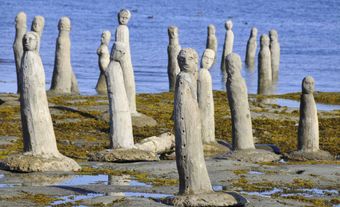Melville Peninsula
The Melville Peninsula is approximately 400 km long and 100 km wide. It is joined to the Canadian mainland by Rae Isthmus, is bounded on its west side by Committee Bay and is separated from BAFFIN ISLAND in the north by Fury and Hecla Strait; it faces FOXE BASIN in the east.
Uplifted through faulting associated with the Foxe Basin structural depression, it is an erosional remnant of a once widespread sheet of sedimentary rocks that mantled the core of the Canadian SHIELD. It is made up of 2 distinct physiographic regions, with by far the larger part consisting of a dissected plateau that becomes quite mountainous on the west side, rising as high as 900 m. In the northeast corner is a narrow, low-relief coastal plain of more recent limestone.
The Precambrian material forming the upland is 1600 million years old, metamorphosed and granitized Shield. Most of the rocks have been moderately folded and more intensive folding raised the low mountains in the west. The faults and intrusions associated with the peninsula's general uplift have become the focus of erosion, and steep-walled canyons, 90-175 m deep, have developed.
In conjunction with some of the intrusions, formations of iron ore deposits have been found, assessed as an important addition to Canada's iron ore inventory. The high concentration of natural uranium in lake sediments and waters of south Melville Peninsula has been traced to igneous rocks intruded into the Shield bedrock. On the isthmus is the hamlet of REPULSE BAY. The hamlet of HALL BEACH lies on the eastern shore of the peninsula. Both sites have long been occupied by the Inuit because of their abundance of marine mammals.

 Share on Facebook
Share on Facebook Share on X
Share on X Share by Email
Share by Email Share on Google Classroom
Share on Google Classroom

